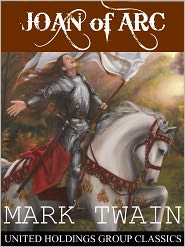“She was Patriotism embodied, concreted, made flesh, and palpable to the touch.”
 A paean to the bravery and spirit of Joan of Arc, this novel by Mark Twain is also his most scholarly, having taken twelve years to write. Clearly fascinated by Joan’s “voices” and her sense of mission, Twain delves into her religious passion and her belief that God has chosen her to free France from England and restore the Dauphin to the throne. Often focusing on the arguments and trials in which Joan participates throughout her life, Twain shows her childhood attempt to “save the fairies,” her struggle to become general of France, and ultimately, her defense against heresy and sorcery. Through these, Twain attempts to reconcile her spiritual commitment with the tumultuous temporal world in which she is engaged.
A paean to the bravery and spirit of Joan of Arc, this novel by Mark Twain is also his most scholarly, having taken twelve years to write. Clearly fascinated by Joan’s “voices” and her sense of mission, Twain delves into her religious passion and her belief that God has chosen her to free France from England and restore the Dauphin to the throne. Often focusing on the arguments and trials in which Joan participates throughout her life, Twain shows her childhood attempt to “save the fairies,” her struggle to become general of France, and ultimately, her defense against heresy and sorcery. Through these, Twain attempts to reconcile her spiritual commitment with the tumultuous temporal world in which she is engaged.
Born in Domremy in 1412, seventy-five years after the beginning of the Hundred Years War, Joan, an Armagnac, supports the isolated Dauphin, son of Charles VI; another faction supports the Duke of Burgundy, allied with the British. When Joan is fifteen, her angelic voices tell her she will lead God’s armies, win back France, and restore the Dauphin. By the time she is seventeen she is General-in-Chief of France. After lifting the siege of Orleans, achieving many victories, and finally, standing beside the Dauphin at his  coronation, she is, however, captured by the Burgundians. Sold to the English, she is later surrendered to an Inquisition in Rouen for trial as a heretic and sorceress. The Dauphin fails to intervene, and at age nineteen she is burned at the stake.
coronation, she is, however, captured by the Burgundians. Sold to the English, she is later surrendered to an Inquisition in Rouen for trial as a heretic and sorceress. The Dauphin fails to intervene, and at age nineteen she is burned at the stake.
Twain creates a fast-paced story about this tumultuous period, creating a series of repeating characters who anchor Joan’s story from the time of childhood until her death. One of these characters is Sieur Louis de Conte, a childhood friend, supporter during battle, and mourner at her execution, who narrates Joan’s story many years later. Rare comic scenes provide occasional changes of mood, and the last section of the novel–Joan’s trial and execution–is dramatic and moving. With the focus on Joan and the arguments she promotes to advance her cause and facilitate her actions, Twain explores the phenomenon of religious passion and the lengths to which a “chosen” person will go to fulfill divine will.
 As interesting as this book is, historically and thematically, it lacks the unity of some of Twain’s other novels. Joan of Arc is so heroic in stature that one feels little emotional connection to her, and Twain’s dialogue is so wooden that the other characters fail to come alive, except as mouthpieces for background or philosophy. On several occasions, Twain explains the historical background (how the war began, and later the Five Great Deeds of Joan of Arc) though these delay the action. A serious attempt by Twain to depict a character with whom he was obviously fascinated, this novel is full of biographical and historical detail, but Joan remains an enigma.
As interesting as this book is, historically and thematically, it lacks the unity of some of Twain’s other novels. Joan of Arc is so heroic in stature that one feels little emotional connection to her, and Twain’s dialogue is so wooden that the other characters fail to come alive, except as mouthpieces for background or philosophy. On several occasions, Twain explains the historical background (how the war began, and later the Five Great Deeds of Joan of Arc) though these delay the action. A serious attempt by Twain to depict a character with whom he was obviously fascinated, this novel is full of biographical and historical detail, but Joan remains an enigma.
Notes: The photo of Mark Twain is from the July 10, 2008, issue of Time magazine, which gave a close-up look at Twain’s politics and how much he was ahead of his time. http://www.time.com/time/covers
The image of Joan of Arc was painted in 1485 and is one of the earliest known pictures of her. http://www.conservapedia.com
